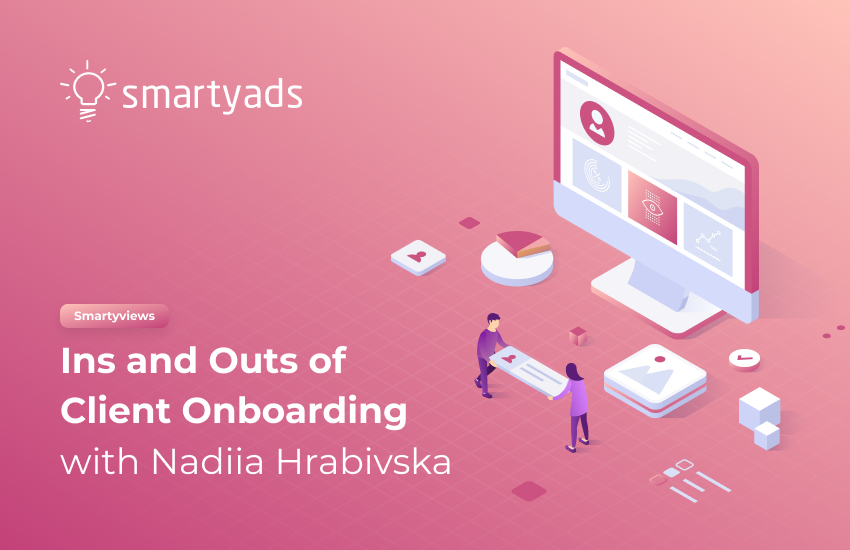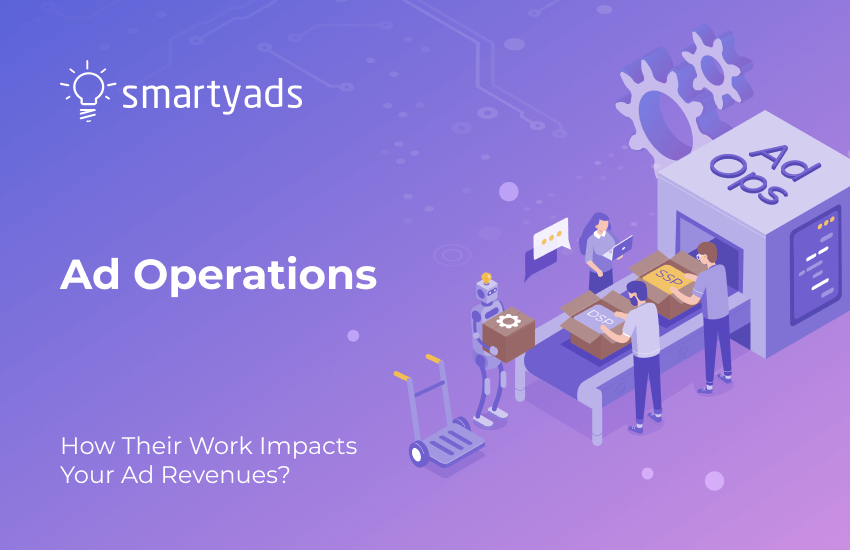Imagine that you enter a restaurant where you have never been before: you wonder if you need to approach the waiter, sit down at the table or make an order at the cash register. The same situation happens when you start using new software or app — when you don’t know where to tap and where to look for certain functions, your experience turns into blind guessing.
Just like a user of a new application or a visitor to a website, users of ad tech platforms also need to go through the product adaptation in order to learn the functions and pinpoint how to use them to get the most out of the product.
If you don't want your retention efforts to be wasted for nothing, the most important things that you need to have in place is a good client onboarding process and a reliable support team. Last time with Lila Matsokha, we discovered the key principles of a successful support team, today with Nadiia Hrabivska, Account Manager WLS of solutions, we are going to find out how to build an onboarding process so that your business multiplies satisfied customers every year.
Nadia, welcome, and thank you for providing us with another opportunity to find out more about your work along with valuable narrow-niche ad tech insights. For starters, can you tell us what client onboarding is and why it is so important nowadays?
The first experience of using the product is the most important, especially in ad tech. If a person is initially confused, encounters difficulties, and struggles to understand the interface, then such a person will unlikely become your client.
Roughly speaking, when a person decides to become your client, it is because they believe you will help them to solve a particular task — in our case, this task is a quick and seamless installation of ad tech software. The sooner your client can solve this task, the more likely they will stay satisfied with your product or service. This requires a thorough onboarding. Ideally, clients should see the value of what you offer from the first steps of their customer journey.
Okay, what about client onboarding in ad tech? Is it also so important?
Yes, in fact, somehow, it is even more important than in other tech niches. Do you know why? Because the digital advertising ecosystem is known to be tremendously complicated. People often ask me, “what does a white label mean in business”? I start explaining to them the specifics of our product, but then, at some point, I notice that I actually need to start with the basics and tell them what is demand side platform or supply-side platform. There are different clients, and while some of them are well-versed in programmatic, others are new to this business and thus need additional support. Some enterprises also don’t have teams to operate and adjust the platforms we provide them with. Exactly for this reason, we decided to pioneer the niche and support their clients with outstaffing ad tech services.
What tasks does onboarding solve at your organization?
Correct onboarding solves several problems at once. The first one is education; the user learns to interact with the WL platform and adjust it according to their own needs and objectives. With our solutions, enterprises create their own ad tech platform, and of course, it can be complicated to learn how to operate it. We have an onboarding procedure that includes setting up educational calls with clients, issuing manuals and videos that explain the peculiarities of platform operation and running performance analysis.
The second task is involvement. Our customer care reaches far beyond average tech support. Our team is proactive and regularly reaches out to clients in order to make sure that they reach desired results. We provide timely consultations so that the businesses of our partners would be profitable because the success of our partners determines our own success.
The third task is maximizing the client’s profit in real time since it is the main essence of the platform's functioning. The right timely onboarding can accelerate the process of platform adoption so that the client could see the true value that our product brings. As a result, the client learns how to correctly operate the platforms and achieves desired profits early on.
I just wanted to ask “how do you normally onboard your clients” but you’ve already given me a glimpse of it. Tell me more about this procedure.
We care about our partners and the results that they achieve with our white-label solutions. That’s why onboarding doesn't end with a series of entry calls or educational training. As practice shows, customers can pretty much excel at learning platform functions themselves. However, as often happens with tech products, they overlook or forget about additional leverages that can actually boost platform performance. This means that they can miss out on the benefits of the product that would make their work easier and save them time and money. That’s why we reach out to let users know about the different features of a service or product.
Our account managers also regularly monitor the performance of white-label solutions that our partners operate and always provide friendly support and consultation on how to set up and use particular functions and platform as a whole.
Do you have a standard onboarding for all your solutions?
Nope, we have developed different onboarding scenarios for various types of products within the white-label solution niche. For example, onboarding for WL SSP + Ad Exchange will be different from onboarding for WL DSP and so on. Each onboarding is a multilayered program, so it includes a lot of steps. Describing them all in detail would take a lot of time and space in this article, so I'll try to briefly describe how it is happening, for instance, when you decide to acquire our WL SSP + Ad Exchange.
First of all, we determine if the client needs the development of additional features, if yes, then our representative handles all communication with the client till custom development is done. Afterward, the standard onboarding procedure is started. Before the platform is introduced to a client, the account manager makes sure everything is in place, working, and corresponds to the agreement. Additionally, we have created onboarding according to the client type — experienced or inexperienced, they are based on different approaches.
Sounds interesting, what is the difference between onboarding for experienced and inexperienced clients?
These are different approaches that take into consideration the fact that our clients are different and so they require different onboarding, including the initial product presentation and familiarization. Our aim is to ensure that each client is aware of how to use different tools for performance optimization. The sooner they start operating and optimizing their platform, the sooner they will be able to achieve profits.
For example, once the platform’s deployment is done, an account manager is scheduling the call for the demo presentation. In case the client is not experienced, prior to this step, they also receive an educational video on how real-time bidding works. After this, the account manager schedules another call with such a client. On this call, the account manager provides additional clarifications regarding the RTB ecosystem, issues admin access to the platform, and demonstrates platform capabilities. When we deal with experienced clients, we also inform them about our outstaffing services and explain how ad tech businesses can benefit from it.
What about the post-launch servicing that you’ve mentioned earlier?
Yes, the customer care doesn’t end at the onboarding stage, that’s what differentiates our service from many others. Both experienced and inexperienced clients get ongoing consultations and support from our team. An account manager constantly analyzes the client’s performance to find out what can be improved (and shares results with the client), provides educational articles, asks to review them, and suggests jumping on the call for further discussion.
We also constantly update the knowledge base regarding each product to make sure that our clients easily find the answers to the questions they need. While navigating such a knowledge base, users instantly reach the subject they need, so in many cases, they don’t have to call support.
Well, Nadia, it was quite informative. I bet the onboarding practices discussed today can be adopted by many businesses, not only ad tech ones. Thank you for your time and for your professionalism. The last question will be, how did you manage to build such a great onboarding in SmartyAds?
Well, to make high-quality onboarding, you need to base it on your audience's goals and the product's value. That’s how we created the right sequence of actions for onboarding in SmartyAds. You need to understand the purpose of your audience and what is most important for them in your product. As you see we divided the audiences into segments depending on their needs. Then, for each of these two groups, we determined their main pain points, barriers of usage, and the main purposes for use. If you have a portrait of the audience and you understand what their goals and motives are, then you can skip this step. If not, it will be a good practice to analyze them.
Also, during the onboarding, the client should feel cared for, and you should demonstrate that you want to solve their problems. For this, you need to maintain an emotional connection and engage your clients to learn more about technology capabilities so that they progressively grew their solutions and achieved greater results.




